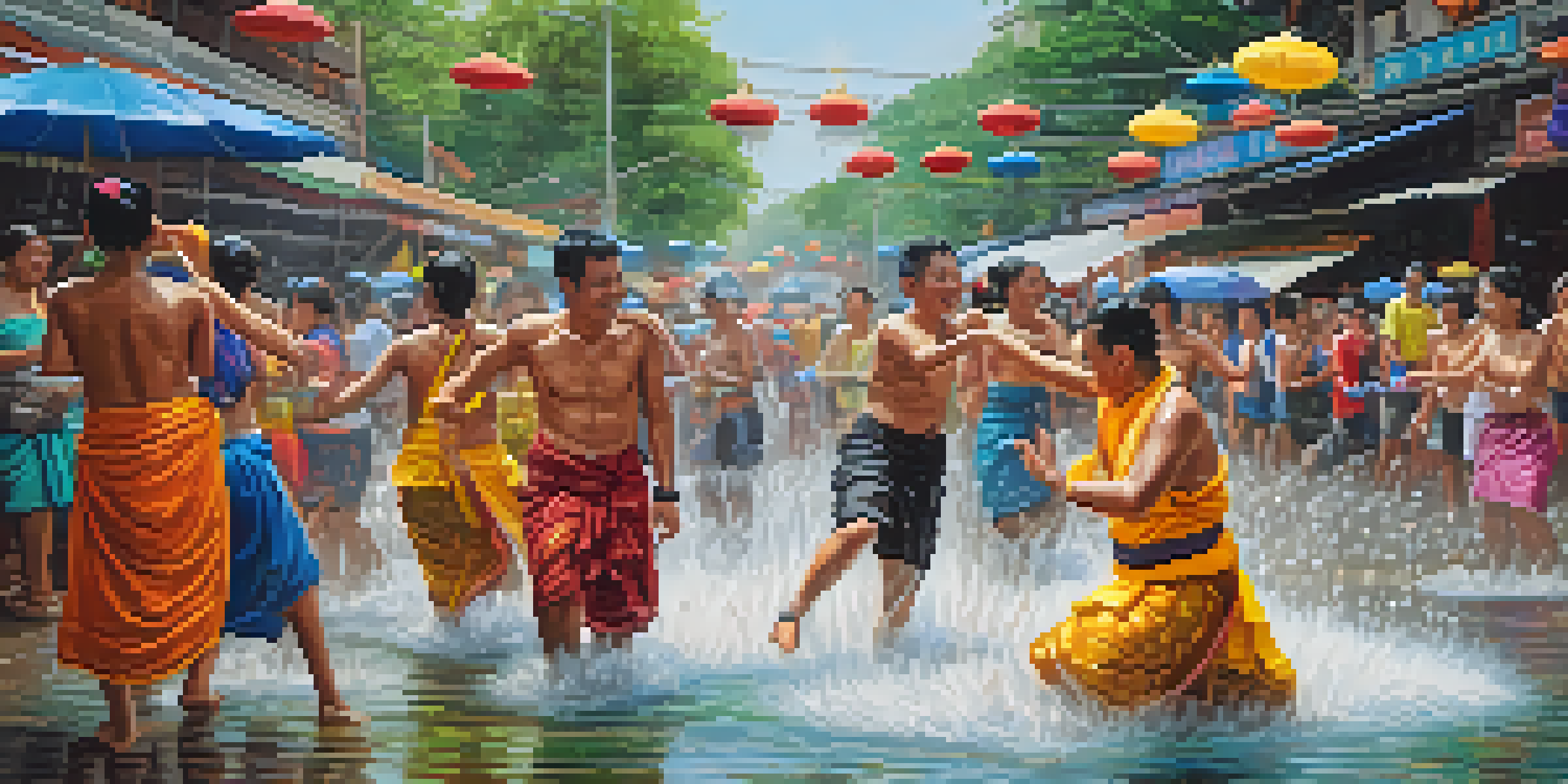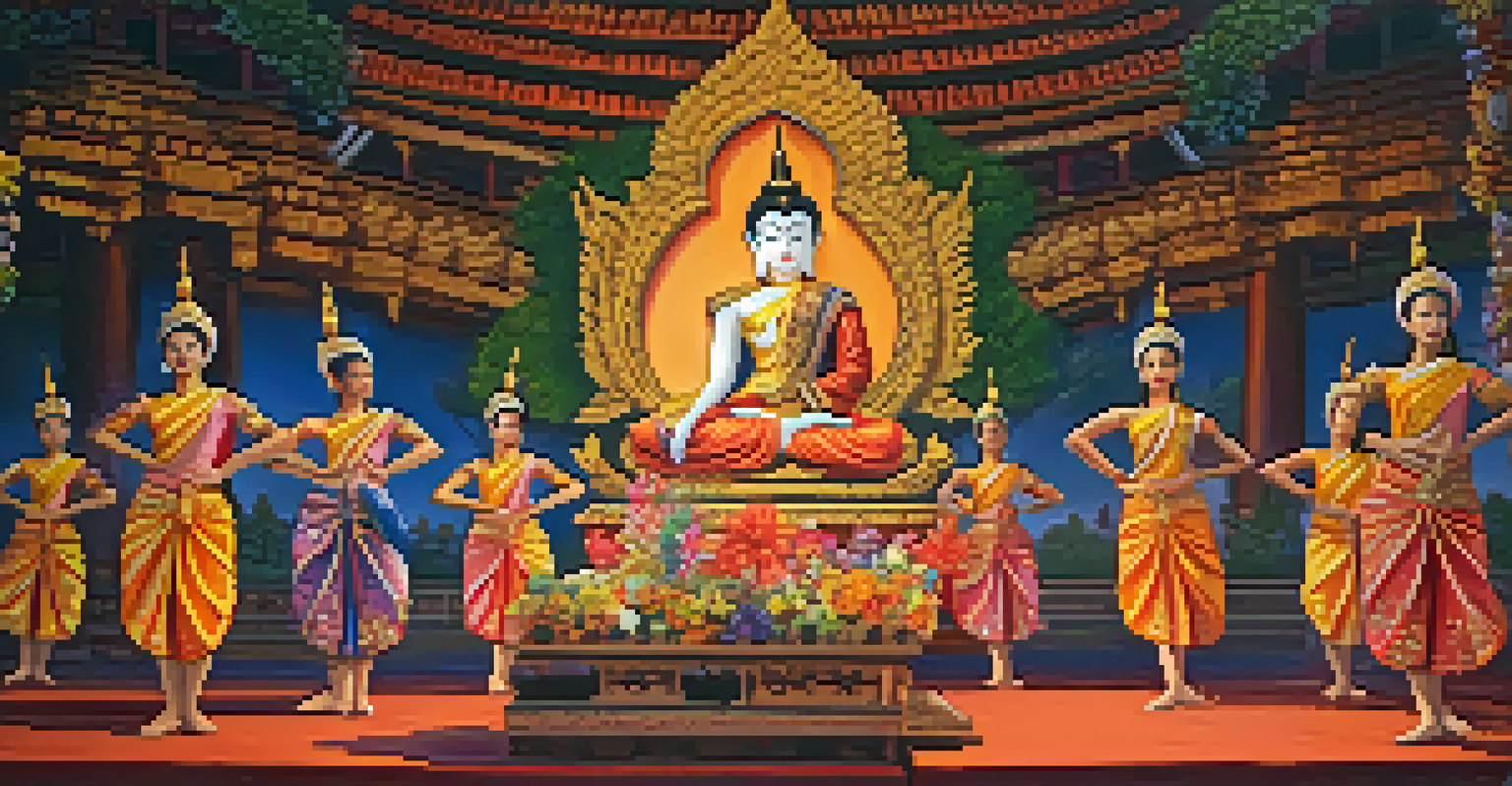Buddhist Festivals and Their Impact on Thai Tourism

Introduction to Buddhist Festivals in Thailand
Buddhist festivals in Thailand are vibrant celebrations that reflect the country's rich culture and spiritual heritage. These events, steeped in tradition, attract both locals and tourists, creating a fascinating fusion of devotion and festivity. With each festival varying in significance and style, visitors often find themselves immersed in unique experiences that showcase Thailand's diversity.
Festivals are a way to bring people together, to share in the joy and the rich tapestry of culture that defines us.
From the colorful parades to the serene candlelit ceremonies, these festivals provide a glimpse into the heart of Thai Buddhism. Notable festivals like Songkran, the Thai New Year, and Loy Krathong, the Festival of Lights, offer visitors a chance to engage with local customs and traditions. This cultural immersion is a major draw for tourists seeking authentic experiences that go beyond typical sightseeing.
As tourists explore these celebrations, they also contribute to local economies. The influx of visitors during these peak times helps support small businesses, artisans, and local markets, creating a symbiotic relationship between tourism and cultural preservation.
Songkran: The Thai New Year Festival
Songkran, held annually in April, is perhaps the most famous Buddhist festival in Thailand, known for its lively water fights and festive atmosphere. This celebration marks the Thai New Year and symbolizes cleansing and renewal, where participants splash water as a ritualistic way to wash away sins and bad luck. The joyful chaos of water fights draws tourists from around the globe, eager to join in the fun.

Beyond the playful water battles, Songkran features traditional rituals, such as visiting temples and pouring water over Buddha statues. These practices allow visitors to witness the spiritual significance of the festival, deepening their understanding of Thai culture. Many tourists often find themselves participating in these traditions, fostering a sense of connection with the local community.
Buddhist Festivals Boost Tourism
Buddhist festivals in Thailand attract tourists, creating economic opportunities and fostering cultural exchange.
The economic impact of Songkran is substantial, with hotels, restaurants, and local vendors experiencing a boom during this festive season. The festival not only attracts tourists but also encourages them to extend their stay, exploring Thailand's beautiful landscapes and rich history.
Loy Krathong: A Festival of Lights
Loy Krathong, celebrated on the full moon of the 12th month in the Thai lunar calendar, is another enchanting festival that captivates both locals and tourists. The festival involves floating intricately designed baskets, or 'krathongs', on rivers and lakes, symbolizing the release of negativity and the welcoming of good fortune. This stunning visual spectacle, with thousands of glowing krathongs illuminating the waterways, is a sight to behold.
Traveling allows us to experience the world through the lens of different cultures, fostering a deeper understanding of our shared humanity.
Tourists are often drawn to the serene beauty of Loy Krathong, as they participate in the tradition of making their own krathongs and setting them afloat. This hands-on experience not only creates lasting memories but also fosters a deeper appreciation for Thai customs. The festival also includes traditional dance, music, and food, making it a festive carnival that appeals to all senses.
The economic benefits of Loy Krathong are significant, boosting tourism in cities like Chiang Mai and Bangkok. As visitors flock to these locations to witness the celebrations, local businesses thrive, showcasing the powerful link between cultural festivals and tourism.
Buddhist Festivals: A Cultural Showcase
Buddhist festivals serve as a cultural showcase for Thailand, highlighting the country's artistic and culinary traditions. From intricate temple decorations to delicious street food, these events allow tourists to experience the essence of Thai culture. Artisans often display their crafts during festivals, providing a platform for local talent while enhancing the overall festive atmosphere.
Moreover, these festivals often feature traditional performances, such as dance and music, which are deeply rooted in Thai heritage. Tourists are not just passive observers; they are encouraged to participate and engage with the culture, creating a rich, interactive experience. This cultural immersion is invaluable, as it fosters mutual respect and understanding between visitors and locals.
Songkran: A Splash of Culture
Songkran, the Thai New Year, combines festive water fights with deep-rooted spiritual rituals, enhancing visitor engagement.
The preservation of these traditions through festivals is crucial, as it helps maintain Thailand's unique identity in an increasingly globalized world. By attracting tourists, these celebrations play a pivotal role in sustaining cultural heritage while also generating economic benefits.
Ecotourism and Sustainable Practices
With the rise of ecotourism, many Buddhist festivals are increasingly focusing on sustainability and environmental consciousness. Organizers are implementing eco-friendly practices, such as using biodegradable materials for krathongs and reducing plastic waste during events. This shift not only benefits the environment but also enhances the overall experience for tourists who are more mindful of their ecological footprint.
Visitors are encouraged to participate in clean-up activities following the festivals, promoting a sense of community and responsibility. This collaborative spirit resonates with tourists, who appreciate the opportunity to contribute positively to the local environment. By aligning cultural celebrations with sustainability, Thailand showcases its commitment to preserving both its heritage and natural beauty.
As ecotourism grows, it attracts a niche market of environmentally conscious travelers who seek meaningful experiences that align with their values. This trend benefits local economies while ensuring that the natural landscapes that frame these festivals remain unspoiled for future generations.
Challenges and Opportunities in Festival Tourism
While Buddhist festivals present numerous opportunities for tourism, they also come with challenges. Overcrowding during peak festival times can detract from the overall experience for both tourists and locals. Balancing the influx of visitors with the preservation of local culture and traditions is crucial, as communities strive to maintain their authenticity amidst commercialization.
Moreover, the impact of climate change poses a significant threat to the sustainability of these festivals. Rising temperatures and unpredictable weather patterns can disrupt traditional practices and deter tourists. It's essential for stakeholders to collaborate on innovative strategies that ensure the longevity of these cultural celebrations in the face of environmental challenges.
Emphasis on Sustainability
Many Buddhist festivals are adopting eco-friendly practices to promote sustainability, appealing to environmentally conscious travelers.
Despite these challenges, there is a silver lining. By addressing these issues proactively, Thailand can enhance its tourism offerings while preserving its cultural heritage. Continuous dialogue between local communities, government, and the tourism sector can pave the way for sustainable growth that benefits everyone involved.
Conclusion: The Future of Buddhist Festivals and Tourism
As Thailand continues to evolve as a tourist destination, Buddhist festivals will remain a vital part of its cultural fabric. These celebrations not only attract visitors but also foster a deeper understanding of Thai spirituality and traditions. The unique experiences offered during these festivals create lasting memories for tourists, encouraging them to return and explore more of what Thailand has to offer.
Looking ahead, it is essential for Thailand to embrace sustainable tourism practices, ensuring that the cultural integrity of these festivals is preserved. By promoting responsible tourism and community engagement, the country can uphold its rich heritage while still welcoming the world. This balance will be key in shaping the future of Buddhist festivals and their impact on Thai tourism.

In conclusion, the interplay between Buddhist festivals and tourism is a testament to the resilience of cultural traditions. As more travelers seek authentic experiences, these celebrations will continue to shine as beacons of Thai identity and hospitality, inviting the world to partake in their beauty and significance.